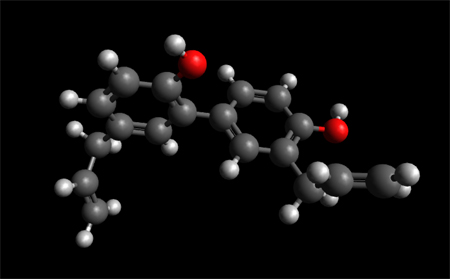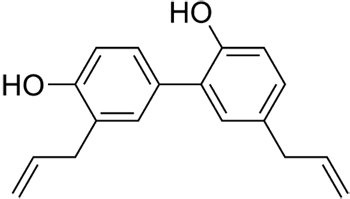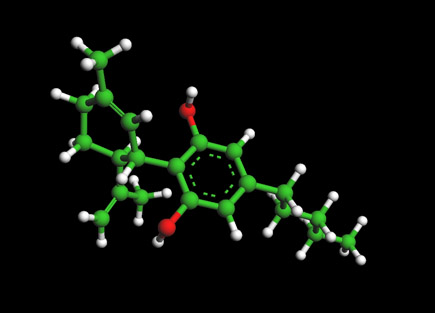Honokiol -- Anti-Aging and role in Cancer and Inflammation
Honokiol (3',5-di-(2-propenyl)-1,1'-biphenyl-2,4'-diol) is a bioactive natural product derived from Magnolia Bark. Recent studies have demonstrated anti-inflammatory, anti-angiogenic, anti-oxidative and anticancer properties of honokiol in vitro and in preclinical models. diseases and age-related pathology... see below--

Ball and Stick Model for Honokiol Molecule
Honokiol Molecule (above) Ball-and-stick. For 3D Jsmol File
Molecular formula: C18H18O2
Molar mass: 266.334 g/mol
Honokiol Molecular Structure

Overview of Honokiol
Honokiol is a lignan isolated from the bark, seed cones, and leaves of trees belonging to the genus Magnolia. It has been identified as one of the chemical compounds in some traditional eastern herbal medicines along with magnolol.
Abstracts:
December 2012 --Honokiol: a novel natural agent for cancer prevention and therapy.
"...Honokiol (3',5-di-(2-propenyl)-1,1'-biphenyl-2,4'-diol) is a bioactive natural product derived from Magnolia spp. Recent studies have demonstrated anti-inflammatory, anti-angiogenic, anti-oxidative and anticancer properties of honokiol in vitro and in preclinical models. Honokiol targets multiple signaling pathways including nuclear factor kappa B (NF-κB), signal transducers and activator of transcription 3 (STAT3), epidermal growth factor receptor (EGFR) and mammalian target of rapamycin (m-TOR), which have great relevance during cancer initiation and progression. Furthermore, pharmacokinetic profile of honokiol has revealed a desirable spectrum of bioavailability after intravenous administration in animal models, thus making it a suitable agent for clinical trials. In this review, we discuss recent data describing the molecular targets of honokiol and its anti-cancer activities against various malignancies in pre-clinical models. Evaluation of honokiol in clinical trials will be the next step towards its possible human applications...." source.
25 July 2017--Honokiol inhibits bladder cancer cell invasion through repressing SRC-3 expression and epithelial-mesenchymal transition
"...Urinary bladder cancer (UBC) is one of the most common urological cancer types. Muscle invasive bladder cancer possesses high propensity for metastasis with poor prognosis. Honokiol is a lignan isolated from Magnolia officinalis with high bioavailability and potent anticancer effects. The results of the present study demonstrated that honokiol significantly inhibited UBC cell migration and invasion in a dose-dependent manner compared with the vehicle-treated control group. In addition, honokiol treatment suppressed epithelial-mesenchymal transition by induction of E-cadherin and repression of N-cadherin. Honokiol was capable of significantly downregulating the expression of cell invasion-associated genes, steroid receptor coactivator-3 (SRC-3), matrix metalloproteinase (MMP)-2 and Twist1. Notably, the inhibition of UBC cell invasion by honokiol was reversed by reintroduction of oncoprotein SRC-3 expression, with the restoration of MMP-2 and Twist1, and reduction of E-cadherin expression. Furthermore, the results of the luciferase assay confirmed that SRC-3 could regulate Twist1 promoter activity. Taken together, the results of the present study suggest that honokiol is a promising agent against UBC cell invasion via downregulation of SRC-3 and its target genes... source
06 February 2018--Honokiol induces apoptosis and autophagy via the ROS/ERK1/2 signaling pathway in human osteosarcoma cells in vitro and in vivo
"...Osteosarcoma is the most common primary malignant tumor of bone, the long-term survival of which has stagnated in the past several decades. In the present study, we investigated the anticancer effect of honokiol (HNK), an active component isolated and purified from the magnolia officinalis on human osteosarcoma cells. Our results showed that honokiol caused dose-dependent and time-dependent cell death in human osteosarcoma cells. The types of cell death induced by honokiol were primarily autophagy and apoptosis. Furthermore, honokiol induced G0/G1 phase arrest, elevated the levels of glucose-regulated protein (GRP)−78, an endoplasmic reticular stress (ERS)-associated protein, and increased the production of intracellular reactive oxygen species (ROS). In contrast, reducing production of intracellular ROS using N-acetylcysteine, a scavenger of ROS, concurrently suppressed honokiol-induced cellular apoptosis, autophagy, and cell cycle arrest. Consequently, honokiol stimulated phosphorylation of extracellular signal-regulated kinase (ERK)1/2. Furthermore, pretreatment of osteosarcoma cells with PD98059, an inhibitor of ERK1/2, inhibited honokiol-induced apoptosis and autophagy. Finally, honokiol suppressed tumor growth in the mouse xenograft model. Taken together, our results revealed that honokiol caused G0/G1 phase arrest, induced apoptosis, and autophagy via the ROS/ERK1/2 signaling pathway in human osteosarcoma cells. Honokiol is therefore a promising candidate for development of antitumor drugs targeting osteosarcoma..." source15 July 2007 -- Honokiol, a Natural Plant Product, Inhibits Inflammatory Signals and Alleviates Inflammatory Arthritis
"...Honokiol (HNK), a phenolic compound isolated and purified from magnolia, has been found to have a number of pharmacologic benefits, including anti-angiogenic and anti-inflammatory properties. HNK has long been used in traditional Asian medicine without toxic side effects. We and others have extensively studied signaling to B cells by CD40 and its Epstein Barr viral mimic, latent membrane protein 1 (LMP1), which has been implicated in exacerbation of chronic autoimmune disease. We asked whether HNK could inhibit CD40 and LMP1 inflammatory signaling mechanisms. In vivo, HNK stabilized the severity of symptomatic collagen-induced arthritis in both CD40-LMP1 transgenic mice and their congenic C57BL/6 counterparts. Ex vivo studies, including collagen-specific serum Ab and Ag recall responses, as well as CD40 or LMP1-mediated activation of splenic B cells, supported the anti-inflammatory effects of HNK. In mouse B cell lines expressing the human CD40-LMP1 chimeric receptor, CD40- and LMP1-mediated NF-κB and AP-1 activation were abrogated in a dose-dependent manner, with a concomitant decrease in TNF-α and IL-6. These promising findings suggest that the nontoxic anti-inflammatory properties of HNK could be valuable for blocking the autoimmune response..." source
October 2012 -- Honokiol promotes non-rapid eye movement sleep via the benzodiazepine site of the GABAA receptor in mice
Honokiol promoted NREM sleep by modulating the benzodiazepine site of the GABAA receptor, suggesting potential applications in the treatment of insomnia, especially for patients who experience difficulty in falling and staying asleep. see full article
11 September 2013 -- Neuro-Modulating Effects of Honokiol: A Review
Honokiol is a poly-phenolic compound that exerts neuroprotective properties through a variety of mechanisms. It has therapeutic potential in anxiety, pain, cerebrovascular injury, epilepsy, and cognitive disorders including Alzheimer’s disease. It has been traditionally used in medical practices throughout much of Southeast Asia, but has now become more widely studied due to its pleiotropic effects. Most current research regarding this compound has focused on its chemotherapeutic properties. However, it has the potential to be an effective neuroprotective agent as well. This review summarizes what is currently known regarding the mechanisms involved in the neuroprotective and anesthetic effects of this compound and identifies potential areas for further research. Keywords: honokiol, neuroprotection, GABA, stroke, inflammatory pain, amyloid, magnolol, analgesia... see full article
Anti-Aging and Senolytics Home Page
- What is Anti-Aging Medicine
- What is Senescence?
- What are Senolytics?
- About Caloric Restriction
- Mtor and Rapamycin
- The IKK/NF-κB signaling pathway in aging
- Exercise and Anti-Aging
- Meditation and Anti-Aging
SENOLYTIC AND ANTI-AGING MOLECULES
RAPAMYCIN ---The mechanistic target of rapamycin (mTOR) pathway has a central role in cell activation...
METFORMIN -- The diabetes drug metformin used by some for anti-aging may diminish benefits of aerobic exercise...
QUERCETIN-- AND WITH DASATINIB--The senolytic cocktail, dasatinib plus quercetin, which causes selective elimination of senescent cells...
FISETIN--Of the 10 flavonoids tested, fisetin was the most potent senolytic...
EGCG- The most active component of green tea....
NAD BOOSTERS --'...The cells of the old mice were indistinguishable from the young mice, after just one week of treatment...
SULFORAPHANE-- An isothiocyanate present in cruciferous vegetables activates antioxidant and anti-inflammatory responses by ...
UROLITHIN --Metabolite of Pomegranate compound with anti-aging effects passes human trial...
MITO-Q -- A water soluble fomr of CoQ10 that has excellent absorption and high bioavailability...
HONOKIOL - A bioactive natural product derived from Magnolia Bark have demonstrated ...
CURCUMIN AND ANALOGS -Recent research is focused on the design and synthesis of curcumin analogs as antiproliferative and anti-inflammatory agents...
BERBERINE --berberine has recently been reported to expand life span in Drosophila melanogaster, and attenuate premature cellular senescence
N-ACETYL-CYSTINE (NAC)--"...pretreatment with NAC increased glutathione levels in the older cells and largely helped offset that level of cell death..."
PIPERLONGUMINE - A natural product from the Long pepper with high bioavailability...
RESVERATROL AND PTEROTSILBINE -- Pterostilben chemically similar to resveratrol bute differs from resveratrol by exhibiting increased bioavailability (80% compared to 20% in resveratrol)
SPERMIDINE--Spermidine delays aging in humans ...
ALLICIN -- Allicin is a compound produced when garlic is crushed or chopped. ...
VITAMIN D3 -- Production of the active forms of Vitamin D are reduced by 50% as a result of an age-related decline
VITAMIN K-- evidence suggests vitamin K has an anti-inflammatory action
TOCOTRIENOL(AND WITH QUERCETIN) --Tocotrieniols have been found to exert a synergistic antitumor effect on cancer cells when given in combination....
HSP-90 INHIBITORS --As a novel class of senolytics
The Cannabidiol Molecule
Cannabidiol (CBD is the major non-psychoactive component of Cannabis and is being looked at by major drug and consumer companies for various medical and social uses.